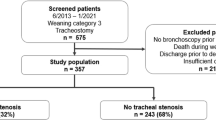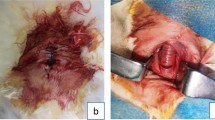Summary
To apply a new airway treatment to humans, preclinical studies in an appropriate animal model is needed. Canine, porcine and leporine tracheas have been employed as animal airway stenosis models using various methods such as chemical caustic agents, laser, and electrocautery. However, existing models take a long time to develop (3–8 weeks) and the mechanism of stenosis is different from that in humans. The aim of the present study was to establish a new and fast tracheal stenosis model in pigs using a combination of cuff overpressure intubation (COI) and electrocautery. Fourteen pigs were divided into three groups: tracheal cautery (TC) group (n=3), COI group (n=3), and COI-TC combination group (n=8). Cuff overpressure (200/400/500 mmHg) was applied using a 9-mm endotracheal tube. Tracheal cautery (40/60 watts) was performed using a rigid bronchoscopic electrocoagulator. After intervention, the pigs were observed for 3 weeks and bronchoscopy was performed every 7 days. When the cross-sectional area decreased by > 50%, it was confirmed that tracheal stenosis was established. The time for tracheal stenosis was 14 days in the TC group and 7 days in the COI-TC combination group. In the COI group, no stenosis occurred. In the COI-TC group, electrocautery (40 watts) immediately after intubation for >1 h with a cuff pressure of 200 mmHg or more resulted in sufficient tracheal stenosis within 7 days. Moreover, the degree of tracheal stenosis increased in proportion to the cuff pressure and tracheal intubation time. The combined use of cuff overpressure and electrocautery helped to establish tracheal stenosis in pigs rapidly.
Similar content being viewed by others
References
Ernst A, Herth FJF. Principles and Practice of Interventional Pulmonology: Springer New York; 2012.
Beamis JF Jr. Interventional pulmonology techniques for treating malignant large airway obstruction: an update. Curr Opin Pulm Med, 2005,11(4):292–295
Xavier RG, Sanches PR, de Macedo Neto AV, et al. Development of a modified Dumon stent for tracheal applications: an experimental study in dogs. J Bras Pneumol (Portuguese), 2008,34(1):21–26
Herth FJ, Eberhardt R. Airway stent: what is new and what should be discarded. Curr Opin Pulm Med, 2016,22(3):252–256
Kwon CI, Kim G, Jeong S, et al. Bile Flow Phantom Model and Animal Bile Duct Dilation Model for Evaluating Biliary Plastic Stents with Advanced Hydrophilic Coating. Gut Liver, 2016,10(4):632–641
Flannery A, Daneshvar C, Dutau H, et al. The Art of Rigid Bronchoscopy and Airway Stenting. Clin Chest Med, 2018,39(1):149–167
Marquette CH, Mensier E, Copin MC, et al. Experimental models of tracheobronchial stenoses: a useful tool for evaluating airway stents. Ann Thorac Surg, 1995,60(3):651–656
Kim HJ, Koh WJ, Suh GY, et al. The Usefulness and Safety of Natural Stent in a Canine Model of Tracheal Stenosis. Tuberc Respir Dis, 2002,53(4):431–438
Lee HS, Kim SW, Oak C, et al. Rabbit model of tracheal stenosis induced by prolonged endotracheal intubation using a segmented tube. Int J Pediatr Otorhinolaryngol, 2015,79(12):2384–2388
Lee SS, Shin JH, Woo CW, et al. A new model of tracheal stenosis in dogs using combined bronchoscopic electrocautery and ethanol injection. J Vasc Interv Radiol, 2008,19(5):764–769
Vandemoortele T, Laroumagne S, Bylicki O, et al. Endobronchial treatment of complete tracheal stenosis: report of 3 cases and description of an innovative technique. Ann Thorac Surg, 2013,95(1):351–354
Esteller-Moré E, Ibañez J, Matiñó E, et al. Prognostic factors in laryngotracheal injury following intubation and/or tracheotomy in ICU patients. Eur Arch Otorhinolaryngol, 2005,262(11):880–883
Li M, Yiu Y, Merrill T, et al. Risk Factors for Posttracheostomy Tracheal Stenosis. Otolaryngol Head Neck Surg, 2018,159(4):698–704
Su Z, Li S, Zhou Z, et al. A canine model of tracheal stenosis induced by cuffed endotracheal intubation. Sci Rep, 2017,7:45357
Eliashar R, Eliachar I, Gramlich T, et al. Improved canine model for laryngotracheal stenosis. Otolaryngol Head Neck Surg, 2000,122(1):84–90
Halum SL, Ting JY, Plowman EK, et al. A multi-institutional analysis of tracheotomy complications. Laryngoscope, 2012,122(1):38–45
Liu J, Zhang CP, Li Y, et al. Post-intubation tracheal stenosis after management of complicated aortic dissection: a case series. J Cardiothorac Surg, 2015,10:148
Wain JC, Jr. Postintubation tracheal stenosis. Semin Thorac Cardiovasc Surg, 2009,21(3):284–289
Marino PL. The ICU Book, Chapter 28. The Ventilator-Dependent Patient: Wolters Kluwer Health/Lippincott Williams & Wilkins; 2014.
Knowlson GT, Bassett HF. The pressures exerted on the trachea by endotracheal inflatable cuffs. Br J Anaesth, 1970,42(10):834–837
Leigh JM, Maynard JP. Pressure on the tracheal mucosa from cuffed tubes. Br Med J, 1979,1(6172):1173–1174
Jung Kwon O, Young Suh G, Pyo Chung M, et al. Tracheal stenosis depends on the extent of cartilaginous injury in experimental canine model. Exp Lung Res, 2003,29(6):329–338
Verkindre C, Brichet A, Maurage CA, et al. Morphological changes induced by extensive endobronchial electrocautery. Eur Respir J, 1999,14(4):796–799
Acknowledgments
Special thanks to veterinarian Eunseok Auh, technicians Taeseong Park, Chang Young Er, and Jae Wook Kim, who helped with animal experiments at the Preclinical Trial and Training Center of Pusan National University Yangsan Hospital.
Author information
Authors and Affiliations
Corresponding authors
Additional information
Conflict of Interest Statement
The authors have no conflicts of interest to declare.
The study was funded by the National Research Foundation of Korea (No. NRF-2017R1C1B5076493).
Rights and permissions
About this article
Cite this article
Kim, J.H., Ahn, J.J., Jegal, Y. et al. Rapid Establishment of Tracheal Stenosis in Pigs Using Endotracheal Tube Cuff Overpressure and Electrocautery. CURR MED SCI 41, 329–335 (2021). https://doi.org/10.1007/s11596-021-2351-0
Received:
Accepted:
Published:
Issue Date:
DOI: https://doi.org/10.1007/s11596-021-2351-0




